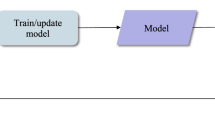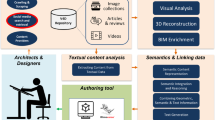Abstract
With the popularity of mobile devices and various sensors, the local geographical activities of human beings can be easily accessed than ever. Yet due to the privacy concern, it is difficult to acquire the social connections among people possessed by services providers, which can benefit applications such as identifying terrorists and recommender systems. In this paper, we propose the location-aware acquaintance inference (LAI) problem, which aims at finding the acquaintances for any given query individual based on solely people’s local geographical activities, such as geo-tagged posts in Instagram and meeting events in Meetup, within a targeted geo-spatial area. We propose to leverage the concept of active learning to tackle the LAI problem. We develop a novel semi-supervised model, active learning-enhanced random walk (ARW), which imposes the idea of active learning into the technique of random walk with restart (RWR) in an activity graph. Specifically, we devise a series of candidate selection strategies to select unlabeled individuals for labeling and perform the different graph refinement mechanisms that reflect the labeling feedback to guide the RWR random surfer. Experiments conducted on Instagram and Meetup datasets exhibit the promising performance, compared with a set of state-of-the-art methods. With a series of empirical settings, ARW is demonstrated to derive satisfying results of acquaintance inference in different real scenarios.
















Similar content being viewed by others
Notes
The connection is aborted on April 20, 2016 (https://www.instagram.com/developer/changelog/).
References
Backstrom L, Leskovec J (2011) Supervised random walks: predicting and recommending links in social networks. In: Proceedings of the forth international conference on web search and web data mining, pp 635–644
Bagci H, Karagoz P (2016) Context-aware friend recommendation for location based social networks using random walk. In: Proceedings of the 25th international conference on world wide web, pp 531–536
Bagci H, Karagoz P (2016) Context-aware location recommendation by using a random walk-based approach. Knowl Inf Syst 47(2):241–260
Barbieri N, Bonchi F, Manco G (2014) Who to follow and why: link prediction with explanations. In: The 20th ACM SIGKDD international conference on knowledge discovery and data mining, pp 1266–1275
Chen K, Han J, Li Y (2014) HALLP: a hybrid active learning approach to link prediction task. J Comput 9(3):551–556
Cheng R, Pang J, Zhang Y (2015) Inferring friendship from check-in data of location-based social networks. In: Proceedings of the 2015 IEEE/ACM international conference on advances in social networks analysis and mining, pp 1284–1291
Cho E, Myers SA, Leskovec J (2011) Friendship and mobility: user movement in location-based social networks. In: Proceedings of the 17th ACM SIGKDD international conference on knowledge discovery and data mining, pp 1082–1090
Choudhury MD, Mason WA, Hofman JM, Watts DJ (2010) Inferring relevant social networks from interpersonal communication. In: Proceedings of the 19th international conference on world wide web, pp 301–310
Crandall DJ, Backstrom L, Cosley D, Suri S, Huttenlocher D, Kleinberg J (2010) Inferring social ties from geographic coincidences. Proc Natl Acad Sci 107(52):22436–22441
Cranshaw J, Toch E, Hone J, Kittur A, Sadeh N (2010) Bridging the gap between physical location and online social networks. In: Proceedings of 12th ACM international conference on ubiquitous computing, pp 119–128
Eagle N, Pentland AS, Lazer D (2009) Inferring friendship network structure by using mobile phone data. Proc Natl Acad Sci 106(36):15,274–15,278
Feng K, Cong G, Bhowmick SS, Ma S (2014) In search of influential event organizers in online social networks. In: International conference on management of data, pp 63–74
Fujiwara Y, Nakatsuji M, Onizuka M, Kitsuregawa M (2012) Fast and exact top-k search for random walk with restart. PVLDB 5(5):442–453
Hsieh H, Yan R, Li C (2015) Where you go reveals who you know: analyzing social ties from millions of footprints. In: Proceedings of the 24th ACM international conference on information and knowledge management, pp 1839–1842
Hu B, Ester M (2014) Social topic modeling for point-of-interest recommendation in location-based social networks. In: 2014 IEEE international conference on data mining, pp 845–850
Jeh G, Widom J (2002) Simrank: a measure of structural-context similarity. In: Proceedings of the eighth ACM SIGKDD international conference on knowledge discovery and data mining, pp 538–543
Li H, Ge Y, Hong R, Zhu H (2016) Point-of-interest recommendations: Learning potential check-ins from friends. In: Proceedings of the 22nd ACM SIGKDD international conference on knowledge discovery and data mining, pp 975–984
Li J, Xia F, Wang W, Chen Z, Asabere NY, Jiang H (2014) Acrec: a co-authorship based random walk model for academic collaboration recommendation. In: 23rd international world wide web conference, pp 1209–1214
Li K, Lu W, Bhagat S, Lakshmanan LVS, Yu C (2014) On social event organization. In: The 20th ACM SIGKDD international conference on knowledge discovery and data mining, pp 1206–1215
Liben-Nowell D, Kleinberg JM (2003) The link prediction problem for social networks. In: Proceedings of the ACM CIKM international conference on information and knowledge management, pp 556–559
Liu S, Wang B, Xu M (2017) Event recommendation based on graph random walking and history preference reranking. In: Proceedings of the 40th international ACM SIGIR conference on research and development in information retrieval, pp 861–864
Liu X, He Q, Tian Y, Lee W, McPherson J, Han J (2012) Event-based social networks: linking the online and offline social worlds. In: The 18th ACM SIGKDD international conference on knowledge discovery and data mining, pp 1032–1040
Lu L, Zhou T (2011) Link prediction in complex networks: a survey. Physica A 390(6):1150–1170
Manikonda L, Hu Y, Kambhampati S (2014) Analyzing user activities, demographics, social network structure and user-generated content on Instagram. arXiv:1410.8099
McPherson M, Smith-Lovin L, Cook JM (2001) Birds of a feather: homophily in social networks. Ann Rev Sociol 27(1):415–444
Medina RM, Hepner GF (2008) Geospatial analysis of dynamic terrorist networks. Springer, Dordrecht, pp 151–167
Medina RM, Hepner GF (2013) The geography of international terrorism: an introduction to spaces and places of violent non-state groups. CRC Press, Boca Raton
Mengshoel OJ, Desai R, Chen A, Tran B (2013) Will we connect again? machine learning for link prediction in mobile social networks. In: Proceedings of the 11th international workshop on mining and learning with graphs
Myers S, Leskovec J (2010) On the convexity of latent social network inference. In: Advances in neural information processing systems, pp 1741–1749
Pan J, Yang H, Faloutsos C, Duygulu P (2004) Automatic multimedia cross-modal correlation discovery. In: Proceedings of the tenth ACM SIGKDD international conference on knowledge discovery and data mining, pp 653–658
Pham H, Shahabi C, Liu Y (2013) EBM: an entropy-based model to infer social strength from spatiotemporal data. In: Proceedings of the ACM SIGMOD international conference on management of data, pp 265–276
Redi M, Quercia D, Graham LT, Gosling SD (2015) Like partying? your face says it all. Predicting the ambiance of places with profile pictures. In: Proceedings of the ninth international conference on web and social media, pp 347–356
Sadilek A, Kautz HA, Bigham JP (2012) Finding your friends and following them to where you are. In: Proceedings of the fifth international conference on web search and web data mining, pp 723–732
Scellato S, Noulas A, Mascolo C (2011) Exploiting place features in link prediction on location-based social networks. In: Proceedings of the 17th ACM SIGKDD international conference on knowledge discovery and data mining, pp 1046–1054
Settles B (2010) Active learning literature survey. University of Wisconsin, Madison 52(55–66):11
Souza F, de Las Casas D, Flores V, Youn S, Cha M, Quercia D, Almeida V (2015) Dawn of the selfie era: the whos, wheres, and hows of selfies on Instagram. In: Proceedings of the 2015 ACM on conference on online social networks, pp 221–231
Sparrow MK (1991) The application of network analysis to criminal intelligence: an assessment of the prospects. Soc Netw 13(3):251–274
Sun J, Qu H, Chakrabarti D, Faloutsos C (2005) Neighborhood formation and anomaly detection in bipartite graphs. In: Proceedings of the 5th IEEE international conference on data mining, pp 418–425
Sun Y, Han J, Yan X, Yu PS, Wu T (2011) Pathsim: Meta path-based top-k similarity search in heterogeneous information networks. In: PVLDB
Tong H, Faloutsos C (2006) Center-piece subgraphs: problem definition and fast solutions. In: Proceedings of the twelfth ACM SIGKDD international conference on knowledge discovery and data mining, pp 404–413
Tong H, Faloutsos C, Pan J (2006) Fast random walk with restart and its applications. In: Proceedings of the 6th IEEE international conference on data mining, pp 613–622
Wang C, Ye M, Lee W (2012) From face-to-face gathering to social structure. In: 21st ACM international conference on information and knowledge management, pp 465–474
Wang D, Pedreschi D, Song C, Giannotti F, Barabasi AL (2011) Human mobility, social ties, and link prediction. In: Proceedings of the 17th ACM SIGKDD international conference on knowledge discovery and data mining, pp 1100–1108
Wang H, Li Z, Lee W (2014) PGT: Measuring mobility relationship using personal, global and temporal factors. In: Proceedings of the 14th IEEE international conference on data mining, pp 570–579
Wasserman S, Faust K (1994) Social network analysis: methods and applications, vol 8. Cambridge University Press, Cambridge
Xiao X, Zheng Y, Luo Q, Xie X (2014) Inferring social ties between users with human location history. J Ambient Intell Humaniz Comput 5(1):3–19
Yin P, He Q, Liu X, Lee WC (2014) It takes two to tango: Exploring social tie development with both online and offline interactions. In: Proceedings of the 2014 SIAM international conference on data mining, pp 334–342
Ying JJ, Kuo W, Tseng VS, Lu EH (2014) Mining user check-in behavior with a random walk for urban point-of-interest recommendations. ACM TIST 5(3):40:1–40:26
Zhang JD, Chow CY (2015) Geosoca: Exploiting geographical, social and categorical correlations for point-of-interest recommendations. In: Proceedings of the 38th international ACM SIGIR conference on research and development in information retrieval, pp 443–452
Zhuang H, Tang J, Tang W, Lou T, Chin A, Wang X (2012) Actively learning to infer social ties. Data Min Knowl Discov 25(2):270–297
Acknowledgements
This work was supported in part by Ministry of Science and Technology, ROC, under Contract 105-2221-E-006-140-MY2, 107-2636-E-006-002 and 106-3114-E-006-002. In addition, we also thank the support from Academia Sinica under the Grant AS-107-TP-A05. Also, we would like to thank anonymous reviewers and the editor for their very useful comments and suggestions.
Author information
Authors and Affiliations
Corresponding author
Rights and permissions
About this article
Cite this article
Chen, BH., Li, CT., Chuang, KT. et al. An active learning-based approach for location-aware acquaintance inference. Knowl Inf Syst 59, 539–569 (2019). https://doi.org/10.1007/s10115-018-1196-8
Received:
Revised:
Accepted:
Published:
Issue Date:
DOI: https://doi.org/10.1007/s10115-018-1196-8




